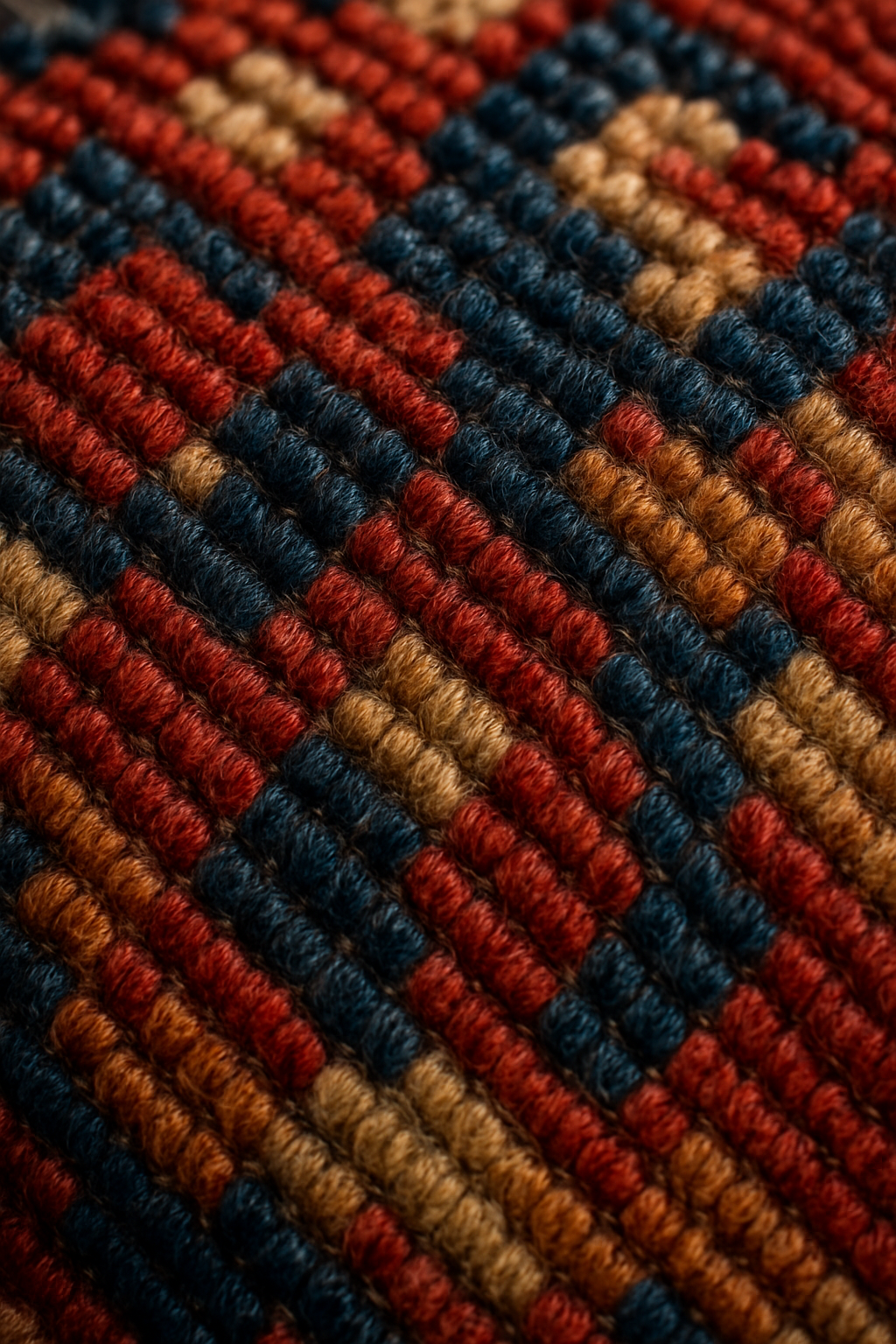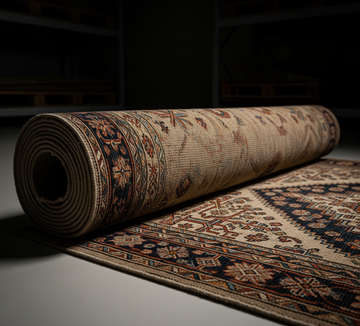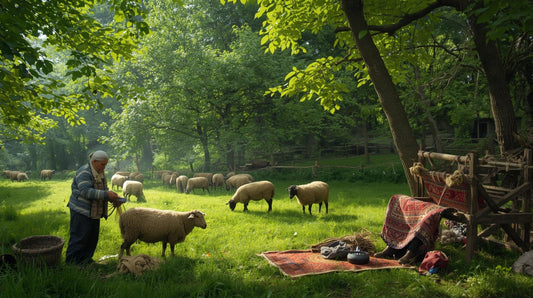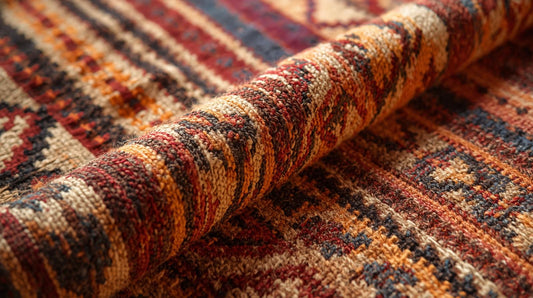Knot Count in Hand-Woven Rugs: The Secret to Quality and a Detailed Guide

The Heart of Carpet Art: Why Knot Count Matters
Hand-woven rugs are more than just floor coverings; they are the embodiment of a deeply rooted art and craft tradition spanning centuries. Each knot encapsulates the weaver's labor, patience, and artistic vision. At the core of understanding the value of these unique pieces lies the concept of "knot count." This concept is a crucial indicator that allows the rug to be perceived not merely as a physical object, but as a work of art and cultural heritage.
Knot count stands out as one of the most critical factors in determining the quality of a hand-woven rug.1 This number directly impacts the rug's durability, the fineness of its patterns, the vibrancy of its colors, and even its market value. A higher knot count signifies increased labor, craftsmanship, and materials used in the rug's production. This elevates the rug's intrinsic value and, consequently, its price, as tying more knots requires a longer duration and greater attention to detail. This guide aims to thoroughly explain the importance of knot count, which forms the foundation of this intricate art form, whether you are purchasing a rug or attempting to understand the value of an existing one.
What is Knot Count? Basic Definitions
In hand-woven rugs, "knot count" refers to the number of knots per specific area of the rug. This metric indicates the density of the rug's weave and, consequently, its quality. The primary measurement used to determine a rug's quality is typically the number of vertical and horizontal knots per square meter (m²).1 This value is referred to as the rug's "knot density."
During the weaving of a rug, a "loop" or "knot" is formed by tying threads, such as wool, silk, or floss, side-by-side in a specific manner around each pair of vertical threads called warps, creating rows.2 These loops form the pile surface of the rug. The way the knot is tied to the warp threads directly affects the rug's overall texture and surface quality. It is important to understand that this fundamental physical process leads to more knots creating a denser and fuller fabric structure. Knot density can also be thought of as the rug's "resolution." Much like pixels in a digital image, each knot acts as a "pixel"; the more knots or pixels in a given area, the more intricate, clear, and detailed the pattern on the rug appears.3
An Indicator of Quality and Durability: The Importance of Knot Count
Knot count is one of the most fundamental factors determining the quality and longevity of a hand-woven rug. A high knot density has direct positive effects on various performance characteristics of the rug.
As the number of knots per square meter increases, the rug's texture becomes tighter and denser, which is a clear sign of a high-quality rug.4 This tight weave allows patterns to emerge more clearly and in greater detail. With each knot functioning like a pixel, fitting more knots into a specific area significantly enhances the complexity and visual clarity of the design on the rug.3 Furthermore, high knot density increases the rug's resistance to wear and color loss, thereby enhancing its durability and extending its product life.3 Indeed, rugs with high knot density are noted to have a lifespan of over 30 years.3 This indicates that a rug with a high knot count is more than a temporary household item; it is a valuable investment that can be used for generations.
The weight of the rug also increases proportionally with the knot count.4 More knots mean more thread material is compressed into a specific area. This increased material density strengthens the rug's structural integrity, making it more resistant to wear and tear. It is accepted that, between two rugs of the same thread type and dimensions, the heavier one is of higher quality than the lighter one.4 Increased density also allows the rug to exhibit better insulation performance, improving both thermal and acoustic insulation properties.4 These physical outcomes demonstrate the direct impact of knot density on the rug's durability and functionality.
How to Measure Knot Count? Different Methods and Tips
Understanding the knot count of a hand-woven rug is key to assessing its quality. There are different units of measurement and practical methods for this assessment.
The most common measurement method is to count the number of vertical and horizontal knots per square meter.1 In some regions, the number of knots per square centimeter (cm²) is used. For example, a well-woven rug can have more than 180 hand-tied knots per square centimeter.6 Hereke silk rugs in Turkey, for instance, typically have an average of 10x10=100 knots per square centimeter.7 This equates to 1,000,000 knots per square meter (100 knots/cm² * 10,000 cm²/m²). Another common international unit of measurement is "KPSI" (Knots Per Square Inch). KPSI is an important indicator of a rug's knot density and overall quality/durability.3
Several methods are available for practically measuring knot count:
-
Inspecting the Back of the Rug: One of the most reliable methods to ascertain the authenticity and knot density of a hand-knotted rug is to examine its reverse side. In a genuine hand-woven rug, the pattern should be clearly visible on the back (though faded), indicating that each knot passes through this surface.8 This method is easily applicable for consumers to distinguish from machine-made rugs and provides a significant clue.
-
10 cm Measurement and Conversion to Square Meter: A 10 cm area is determined lengthwise and widthwise from the underside of the rug. The vertical (height) and horizontal (width) knots in this area are counted. Each bump is counted as a knot for height, while only 90-degree piles are counted for width. The result of this count is then multiplied by 100 to determine the knot density per square meter.1
-
KPSI Calculation: Turn the rug over and count the knots in a 1-inch vertical and 1-inch horizontal area. Multiplying these two numbers gives the overall KPSI value.3
The variety of measurement units used in different regions (square meter, square centimeter, KPSI, Gereh, Redj, etc.) reflects the rich history and cultural weaving traditions of rug making. However, this diversity necessitates conversion factors for international trade and comparisons. This situation also highlights the balance between traditional practices and the global market's need for standardization.
The table below presents the quality classification of hand-woven rugs based on knot density:
|
Quality Level |
Knot Count Range Per Square Meter |
|
Medium Quality |
250,000 to 500,000 knots |
|
Good Quality |
500,000 to 1 million knots |
|
Rare Quality |
1 million to 4 million knots |
|
Very Good Quality |
More than 4 million knots |
|
World Record |
10,800,000 knots |
|
: Hand-Woven Rug Quality Classification 1 |
Knot Types and Their Impact on Quality: Gördes or Senneh?
The knotting technique used in hand-woven rugs directly affects not only the appearance of the rug's pattern but also its durability, lifespan, and thus its value. The two most widely used main knot types globally are the Turkish (Gördes) knot and the Persian (Senneh) knot. These two knot types create a significant distinction in rug quality due to their different tying methods and results.
Turkish Knot (Gördes Knot / Double Knot / Symmetrical Knot):
Named after the Gördes district of Manisa, the Turkish knot is a technique widely used in rugs from Turkey and the Caucasus regions.9 This knot is tied over a double warp; the pile yarn is wrapped around both warp threads, pulled through between the warp threads, and cut.10 This tying method ensures that the knot tightly encircles both warp threads. It is also popularly known as the "tie" knot or "headed loop".9 Rugs woven with the Gördes knot are known for being extremely sturdy and long-lasting.9 Even if the pile of the rug wears down over time, the strong connection of the knot ensures that the pattern is not lost, and it can be used like a kilim for centuries.9 Tying the Turkish knot is more difficult and time-consuming than tying the Persian knot. Therefore, of two rugs with the same knot density, the one with Turkish knots is generally considered more valuable and preferred.13 This knotting technique is often preferred for weaving rugs with geometric patterns.12
Persian Knot (Senneh Knot / Single Knot / Asymmetrical Knot):
Named after the city of Senneh (Sanandaj) in Iran, the Senneh knot is widely used in Turkmen, Chinese, Iranian, and some Indian rugs.9 In this technique, the pile yarn is wrapped around only one warp thread, and the other end of the loop remains free.12 In Gördes, this knot type is also called the "karnıyarık" (stuffed eggplant) knot.9 The knot quality of rugs woven with the Senneh knot is considered weaker compared to the Gördes knot, and the prices of rugs woven with this technique are generally lower.9 However, the Senneh knot allows for a softer weave and enables more knots per square decimeter. Due to this feature, it is preferred for weaving rugs with fine and delicate patterns.12 Also known as the Turkmen knot, this knot can be tied faster.15
The knotting method has a direct impact on the rug's durability, production time, and thus its value. The Gördes knot's wrapping of two warp threads gives it a sturdier structure than the Senneh knot. This structural difference ensures that Gördes-knotted rugs are more long-lasting and retain their patterns better. This explains why a Turkish-knotted rug might be more valuable despite having the same knot density. The choice of knot type reflects a balance between artistic detail and softness (Senneh) versus sturdiness and longevity (Gördes). This indicates that rug quality can be defined not by a single measure, but also by different priorities (e.g., artistic finesse and texture or pure robustness).
Knot Density and Units of Measurement by Region
Hand-woven rug making is a rich tradition nourished by the unique cultural and artistic heritage of each geographical region. These regional differences manifest across a wide spectrum, from the units of measurement used in rug weaving to the knot density standards of the rugs.
As a general approach, the quality of a rug is determined by counting the number of vertical and horizontal knots per square meter.1 However, each country or region has its own unique measurement systems and quality standards:
-
Iranian Rugs: For a long time, "Gereh" (6.4 to 7 cm) was used as a unit of measurement. For example, a 7 cm Gereh square corresponds to 7x7=49 cm², and when converted to square meters, a conversion factor of 204.08 is used (10,000 cm² divided by 49 cm²).1 In the past, knot density was 30 knots/Gereh, but now the decimal system is used.1 Especially in Tabriz rugs, the "Redj" (row) measurement is common. The number of rows woven per Gereh is given; for example, a Tabriz rug with 40 "Redj" contains 40x40=1600 knots per Gereh square. A conversion factor of 204.08 is again used when converting to square meters.1
-
Chinese Rugs: In China, knot count is calculated in rows. A wool rug has 90 knots per 30 cm in the warp and weft directions. The conversion formula is 90 x 3.28 = 295.20 x 295.20 = 87,143 knots/m².1
-
Indian Rugs: In India, knot counts vary according to different quality levels per square meter. For example, Kashmir rugs of 22/22 quality can have 750,000 knots/m², while 24/24 quality can have 900,000 knots/m². Agra rugs, on the other hand, can have 223,200 knots/m² for 9/16 quality and 279,000 knots/m² for 10/18 quality.1
-
Hereke Rugs (Turkey): Silk rugs woven in Hereke, one of Turkey's important rug-making centers, are known for their high knot density. These rugs typically have an average of 10x10=100 knots per square centimeter.7 This equates to 1,000,000 knots per square meter (100 knots/cm² * 10,000 cm²/m²).
The transition from traditional, non-decimal units like Gereh and Redj to the decimal system indicates a significant trend towards standardization in the global rug market and facilitating international comparisons.1 This highlights the need for common metrics for buyers and sellers in different regions to more easily understand and compare quality. Regional differences in knot count and measurement systems also emphasize the unique cultural heritage and artistic priorities of each weaving tradition. For example, the "Redj" measurement in Tabriz might indicate that region's focus on loom setups or linear patterns, adding a rich cultural layer to the technical data.
The table below shows example knot counts for different countries and quality levels:
|
Country/Region |
Quality/Weaving Type |
Approximate Knot Count Per Square Meter |
|
India |
Kashmir 22/22 |
750,000 |
|
India |
Kashmir 24/24 |
900,000 |
|
India |
Agra 9/16 |
223,200 |
|
India |
Agra 10/18 |
279,000 |
|
Turkey |
Hereke Silk |
1,000,000 (100 knots/cm²) |
|
China |
Wool Rug |
87,143 (90 knots per 30 cm) |
|
Iran |
Tabriz (600 knots/Gereh square) |
326,528 |
|
: Example Knot Counts by Country and Quality 1 |
Beyond Knot Count: Other Factors Affecting Rug Quality
While knot count is undoubtedly one of the most important criteria for determining the quality of a hand-woven rug, it is not the sole factor that constitutes the rug's true value and beauty. There are other significant elements that enhance a rug's overall quality and aesthetic appeal.
Yarn Type and Quality: Natural fibers such as wool, silk, or cotton are generally preferred for rug production.14 Each fiber type contributes differently to the rug's texture, durability, and aesthetic appearance. Wool makes the rug warm and soft, while silk adds luster, fineness, and elegance. Cotton, on the other hand, offers a lighter and cooler touch.14 The type of yarn directly affects the rug's overall texture, durability, and aesthetic appearance. Finer fibers, especially silk, allow weavers to achieve much higher knot densities. For example, the average of 100 knots per square centimeter in Hereke silk rugs 7 indicates that the fineness and durability of silk are prerequisites for achieving such high densities. This reveals that for certain very high-quality rugs, fiber selection directly impacts the achievable knot count and, consequently, the artistic intricacy.
Weaver's Skill and Craftsmanship: In hand-woven rugs, the weaver's skill and the quality of craftsmanship are of great importance beyond the knot count. A skilled weaver can tie 800 knots per hour 6, which directly affects the production time and thus the cost of labor. Master weavers play a key role by carefully knotting each thread and creating the rug's pattern by hand.14 The quality of workmanship is decisive for the tightness and regularity of the knots, the precision of the pattern, and the overall finish of the rug. Even and regular knotting enhances the smoothness of the rug's surface and the clarity of the pattern.
Rug's Age, Condition, Harmony of Colors, and Pattern Balance: In addition to knot density, the rug's overall appearance, the harmony of its colors, and the balance of its pattern are also critically important in determining its quality.1 The rug's age and general condition are also factors affecting its value.1 Antique rugs generally have a denser knot count and are more tightly woven, which suggests that age can be related to quality.16 Furthermore, the rug's weight is also an indicator of quality; of two rugs made from the same type of yarn and of the same dimensions, the heavier one is of higher quality because more material was used and it was woven more densely.4 Elements such as the silk ratio, the density of patterns, and the knotting techniques used are also among the factors determining the rug's price.17 The combination of high knot count with superior materials and craftsmanship transforms a rug from merely "good quality" into a "masterpiece" or a "collectible" piece. The excellence of a true hand-woven rug is a synergy resulting from the combination of multiple high-quality elements. This encourages readers not to rely on a single measure but to appreciate the multifaceted nature of rug quality.
Conclusion: The Artistic Value of Hand-Woven Rugs
The knot count in hand-woven rugs signifies much more than just a technical measurement; it is a fundamental element that reflects the rug's soul, the weaver's story, and its artistic heritage. Through this detailed guide, it is possible to better understand why knot count plays such a critical role when evaluating the quality and value of a hand-woven rug. A high knot density not only increases the rug's durability and longevity but also significantly enhances the fineness of its patterns, the vibrancy of its colors, and its overall aesthetic appeal.
This information empowers consumers to make informed purchasing decisions and appreciate the true value of hand-woven rugs. Understanding how knot count is measured, how it affects quality, and its regional variations moves the reader from a superficial appreciation to a deeper understanding. Each hand-woven rug, with its unique knot count and technique, transcends a simple functional object to embody a piece of cultural heritage and human artistry.
In your next rug purchase or when examining your existing rugs, you can use this information to make more informed choices and appreciate the labor and art behind each knot. Hand-woven rugs are unique works of art that add warmth and character to homes, defying time. Understanding their value is to be part of this rich cultural heritage and the shared artistic expression of humanity.
No comments







0 comments